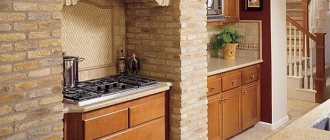- What not to do when remodeling an apartment
- Bathroom remodeling
- Kitchen remodeling
- Redevelopment with a kitchen niche
- Redevelopment of rooms with moving walls
- Redevelopment of a loggia or balcony
- What are the dangers of illegal redevelopment?
- What can be done during redevelopment
- What repairs can be done without a project?
- How to understand whether you can do redevelopment or not
The standard layout of the apartment can be made more convenient, to suit you. Demolish some walls to create more space. Or divide a large room into several small ones so that everyone in the family has their own room.
Despite numerous possibilities, there are repairs that cannot be agreed upon. For example, you cannot increase the room by adding a balcony or remove the door in the kitchen if there is a gas stove. It is better to know about this so as not to waste time and money on a project that cannot be implemented.
In this article we talk about what can and cannot be done when remodeling in specific rooms - in the kitchen, in the room, in the bathroom or on the balcony.
What not to do when remodeling an apartment
Redevelopment is those changes to the apartment that are reflected in its technical plan. Each apartment has this plan; it is stored in the BTI along with the registration certificate. If there is no BTI plan yet (for example, an apartment in a new building), you need to draw it up yourself. We talk about how to do this in this article.
Why do you need a technical plan:
- it shows the boundaries of all rooms, all doorways and window openings;
- All technical and plumbing equipment is marked.
This is an example of a floor plan issued by BTI.
Here you can see all the rooms of the apartment, their area. If you are renovating and planning to cut a new opening in the wall or move walls, be sure to first coordinate the redevelopment project. The planned work must comply with all building codes and sanitary rules. The safety of you and your neighbors living in your home depends on this. It is also important to agree on repairs so as not to receive a fine for illegal repairs and not to redo it.
Moscow Government Decree No. 508-PP - clause 10 of Appendix No. 1 lists all the work that is prohibited from being performed and cannot be agreed upon. Next, in simple language, we will talk about the prohibitions that apply to each specific room of the apartment.
How to combine a bathroom
Important
They often say that you cannot remodel an apartment that is under mortgage - this is not entirely true. If the mortgage agreement does not prohibit redevelopment, you will simply need to provide permission from the bank along with the documents listed above. Before receiving it, first contact an appraiser who will confirm that the value of the apartment will not decrease after redevelopment, and then go to the bank with such good news.
If all that irritates you about your current apartment layout is the bathroom, then you're in luck—there's not much that irritates you. And working with a bathroom during redevelopment cannot be called the most difficult. First, as everywhere else, you need to agree on the project (it may well be standard - you can easily find one in the Catalog of standard redevelopment projects in mass-produced houses)
, and then get to work.
But if you just want to combine a toilet with a bathroom, and there are no utilities in the wall between them, you can do this even without approval. Well, that is, collecting documentation during redevelopment cannot be called a completely meaningless bureaucracy - if your work consists only of removing one interior partition, no one will require special permission from you for this.
In general, it is better to start redevelopment not by breaking down the walls, but by collecting all the necessary documents. Namely, project documentation, BTI technical passport, certificate of ownership (if it has not yet been received, it’s okay, you can do the redevelopment without it, you just need to collect almost more documents)
, perhaps – a technical report from the author of your house project.
Bathroom remodeling
Remodeling a bathroom is the most popular of all: the bathroom and toilet are combined, the bathroom is expanded to cover the area of the corridor. These are considered “wet areas” that need to be repaired correctly so that in the future you don’t flood your neighbors or worsen their living conditions and your living conditions.
We tell you what not to do when remodeling a bathroom.
- You cannot remove the threshold at the entrance to the bathroom. According to clause 4.8 of the Code of Rules 29.13330.2011 “Floors” at the entrance to the bathroom there must be either a threshold at least 2 cm high, or a different floor level in the bathroom and the corridor.
An example of how you can and cannot make a threshold in the bathroom.
Here are the main requirements for the threshold.
! A door frame, baseboard or glued-on piece of foam is not a threshold. It can be made of tiles, with waterproofing material placed on it.
- must not be touched—cut them, make them smaller, or use them as shelves and niches.
This is common property, and under no circumstances should it be used as a closet, moved, or reduced in size to the wall of the box. You can only hang a water heater inside it. If the boxes are on the BTI plan, then they must be preserved, even if the developer did not erect them.
This is how the boxes look on apartment plans.
- You cannot expand the bathroom if the neighbors have a living room below.
When expanding the bathroom onto the corridor area, you should always look at the BTI plans of the neighbors below. If they have already done a redevelopment and the corridor has become a living room, you cannot enlarge your bathroom, since the wet area should not extend into the living space of your neighbors. - You cannot lay tiles without waterproofing the floor. For any repair, it must be done, as there is a risk that pipes will leak, a faucet will break, or someone will forget to turn off the water. Waterproofing refers to hidden work, that is, those that are not visible during the finishing of the repair. To approve the repair, you need to draw up a report on hidden waterproofing work signed by the construction organization.
- You cannot move the bathroom and toilet into the living part of the apartment, or expand the bathroom at the expense of the living room. This is only permissible in one case: if the apartment is on the ground floor. Then there are no neighbors below and there is no risk of flooding them with water in the event of an accident.
An example of all hidden work in an apartment that requires an inspection report:
Increasing the kitchen area by adding a toilet and bathroom
Sanitary standards establish the conditions for how to combine the kitchen and bathroom area and when this is even possible. In some apartment buildings this is the only convenient redevelopment option. According to the requirements of the law, before starting repairs, you need to draw up a plan and coordinate it with inspection organizations such as BTI.
Alteration will not be legalized if it violates sanitary standards and worsens the living conditions of the owner or his neighbors. If you make repairs without permission, then during inspection the owner of the apartment will be fined and forced to return everything back. It is impossible to carry out any transactions for the alienation of real estate without approval and obtaining a new registration certificate.
Prohibitions on increasing kitchen space
The standards are specified by the Housing Code of Russia. Its regulations impose restrictions on expanding the kitchen area by affecting the sanitary facilities, in which:
- it is impossible to place the kitchen or part of it under the wet area of the neighbors above;
- the neighbors below your kitchen should not have a bedroom or living room, even partially;
- combining a balcony or loggia with a kitchen without installing glazing between them is prohibited.
When is it permissible to expand the kitchen at the expense of the bathroom?
The sanitary area of the apartment is not prohibited from being moved or shifted to part of the non-residential area, and the kitchen area can be expanded in its place. This is possible if the toilet and bath are combined or moved to the corridor. In this case, part of the corridor can also be combined with the kitchen. The main thing is that there are no living rooms under or above these rooms. We'll talk about these options in more detail later in the article.
Kitchen remodeling
There are many requirements for a kitchen renovation. The most stringent ones apply to kitchens with a gas stove. It is forbidden:
- you cannot reduce the kitchen so that its area is less than 8 square meters. m.. If it is initially smaller, and this is indicated in the BTI plan, then it should remain the same area - for example, 6 sq.m.;
- combine a kitchen with a gas stove and a living room without installing tightly closing doors or replacing the gas stove with an electric one. These can be regular doors, sliding or glass. Only plastic accordion doors are prohibited;
- move a gas stove without permission from the gas workers, even if the stove has a flexible connection;
- expand the gasified kitchen into the living room and vice versa in apartments on any floors. To combine the kitchen with the room, you need to replace the gas stove with an electric one. Then installing doors is not necessary.
For a kitchen with a gas stove, installing doors is mandatory.
Since gas is explosive, all work with gas equipment must be supervised by Mosgaz technicians. More information about all the requirements for moving a gas stove regarding risers and drainage can be found in our memo:











